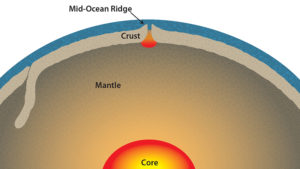WOODS HOLE – The temperature of Earth’s interior affects everything from the movement of tectonic plates to the formation of the planet.
A new study led by Woods Hole Oceanographic Institution (WHOI) suggests the mantle—the mostly solid, rocky part of Earth’s interior that lies between its super-heated core and its outer crustal layer – may be hotter than previously believed.
The new finding, published in the journal Science, could change how scientists think about many issues in Earth science including how ocean basins form.
Determining that temperature isn’t easy.
Since it’s not possible to measure the mantle’s temperature directly, geologists have to estimate it through laboratory experiments that simulate the high pressures and temperatures inside the Earth.
Water is a critical component of the equation: the more water in rock, the lower the temperature at which it will melt.
To figure out how the water content of mantle rock affects its melting point, a series of lab experiments using a piston-cylinder apparatus was conducted, using a machine that uses an electrical current, heavy metal plates, and stacks of pistons in order to magnify force to recreate the high temperatures and pressures found deep inside the Earth.
Based on her results, it was concluded that mantle melting had to be starting at a shallower depth under the seafloor than previously expected.

























